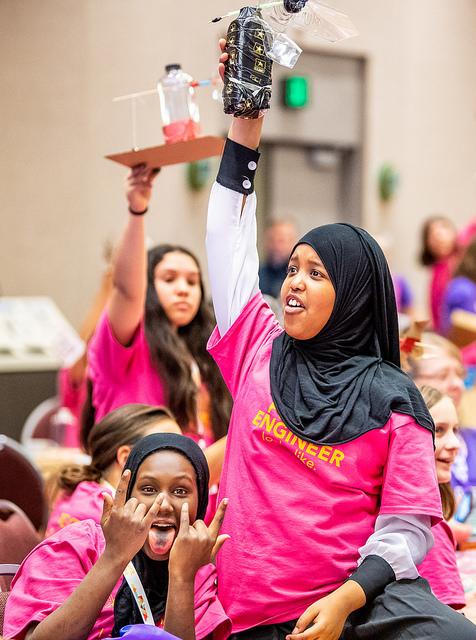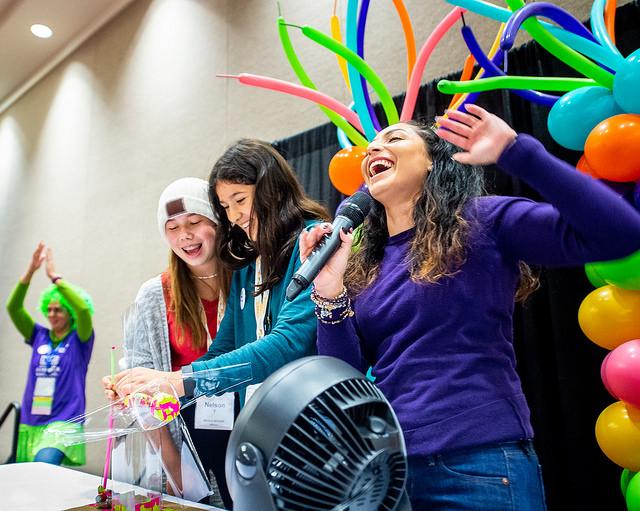Design Squad Global (DSG) has one main goal: make engineering and inventing accessible and exciting for students ages 10-13 around the globe. To achieve this goal, DSG focuses on breaking down stereotypes about engineers and inventors, such as ideas like all professional engineers build bridges, as well as creating content that makes engineering and inventing relatable to kid’s everyday lives, like having kids try designing environmentally-friendly sneakers made from recyclable or biodegradable materials. This goal becomes even more important when thinking about which students are underrepresented in the field of engineering- females and students of color. When looking at who studies engineering in college and who practices engineering as a career, the demographics skew dramatically towards white males. This is why DSG feels it is important to create resources, events, and videos that demonstrates to all students that they too are engineers and inventors.

At DSG events, we see that many kids, especially ones that do not already see themselves as an engineer or inventor, are hesitant to jump into our challenges and start inventing. Time and time again we hear that students are concerned that they will get the wrong answer or “fail” at the activity. But failing is an important step in the design process and crucial to the process of creating new inventions. It is exceedingly rare for professional inventors and engineers to create a perfect solution to their problem on their first try. But it can be tricky to change a student’s thinking about failing, especially with many other forces in education emphasize the importance of having the correct answer. Here are some DSG tips that can help to reframe the concept of failing for students:
- Teach that there is no one, right answer. In the field of engineering and invention there are always multiple solutions for a problem. Try to pick activities for your students that have open-ended answers. For example, challenge them to think of a way to build an eco-friendly house or to invent clothes that are better for the environment. These kinds of challenges encourage students to use STEM principles, but still allow for multiple different solutions to the identified problem.
- Embrace failing as part of the design process. When we teach kids the design process, it is important to emphasize the testing and redesign stage- and explain that this is another way of saying failing and trying again. At DSG we tell kids to “Fail fast, succeed sooner!” This means the quicker you can get to the testing and redesign stage (the failing part), the sooner you will arrive at the final solution!
- Share examples of failures. It is important to normalize failing for kids as well as to stress that we always can learn something from our failures. One example we use at DSG: in 1930 Ruth Wakefield was baking chocolate cookies with a recipe that called for baker’s chocolate, which melts into the dough in the oven. Unfortunately, she was all out of baker’s chocolate, so she experimented with semi-sweet chocolate chips instead. Unlike baker’s chocolate, the chips did not melt into the dough but held their shape. She failed at making chocolate cookies, but she is credited with inventing a new treat, the beloved chocolate chip cookie! What a sweet failure!
- Make failing fun! It is really hard to break the stigma associated with failing, especially for young students. Recently at the Society of Women Engineer’s Invent It Build It event, a day that brings together female students and female engineer mentors, we learned a new trick for getting kids to think about failing differently. Groups of girls were building the new DSG Inventing Green activity called Wind Power Station and tested their designs at fans. If their design did not work, they were encouraged to yell “Epic Fail!” and other students upon hearing this had to cheer and clap. At first, the young engineers were hesitant to yell epic fail, but by the end of the event the auditorium was filled with the sounds of people yelling and cheering for everyone’s failure attempts!

To bring engineering and invention education to all students, especially those underrepresented in the field, it is important to attempt to address barriers that prevent students from engaging in these experiences. By reframing failure as a positive, necessary step in the design process we can reduce hesitancy and increase willingness to trying engineering and inventing.
Try having fun at failing with some of DSG’s favorite activities found at pbskids.org/designsquad/global!

